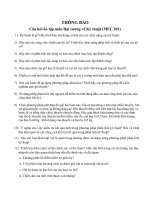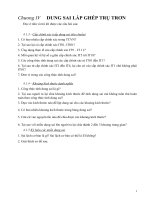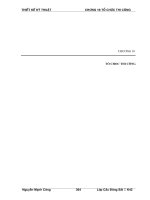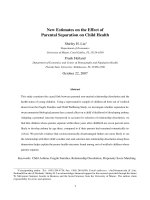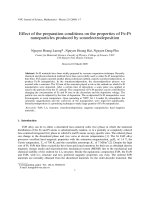Tài liệu Status Report on The Application of Integrated Approaches to Water Resources Management ppt
Bạn đang xem bản rút gọn của tài liệu. Xem và tải ngay bản đầy đủ của tài liệu tại đây (20.05 MB, 119 trang )
Status Report on
The Applicaon of
Integrated Approaches to
Water Resources
Management
2012
Report
Chapter 18 of Agenda 21 called for “the applicaon
of integrated approaches to the development,
management and use of water resources”. UN-
Water has been asked by the UN Commission on
Sustainable Development (UN CSD, at its meeng in
2005) to produce a status report on the progress of
water resources management for Rio+20.
This Status Report, prepared by UNEP in
collaboraon with UNDP and GWP, is based on a
2011 UN-Water survey sent to the governments
of all UN member states. More than 130 countries
have responded to the survey and this data
has been complemented by interviews in 30
representave countries. The report is intended to
inform decision-making at the Rio+20 conference
and follow-up global policy discourses. It will
facilitate informaon exchange to enhance the
coherence and impact of naonal eorts to
improve water resources management and related
work of the UN and other external support agencies
at the country level.
Since 1992, 80% of countries have embarked on
reforms to improve the enabling environment
for water resources management based on the
applicaon of integrated approaches. To ensure
connued progress and posive outcomes in
applying integrated approaches to water resources
management, government and external support
agencies should learn from experience and increase
their eorts.
The high country response to the survey
demonstrates the value of reporng and
emphasizes the need for a more rigorous, evidence-
based, reporng system on progress with water
resources development and management.
Implemenng integrated approaches to water
resources management should remain a key
component of future development paradigms.
PHTO: SHUTTERSTOCK
2012 STATUS REPORT ON THE APPLICATION OF INTEGRATED APPROACHES TO WATER RESOURCES MANAGEMENT
ISBN: 978-92-807-3264-1
Job Number: DEP/1532/NA
www.unep.org
United Naons Environment Programme
P.O. Box 30552 Nairobi 00100, Kenya
tel: +254 20 762 1234
fax: +254 20 762 3927
e-mail:
UN-Water Report on Integrated Approaches in the Development, Management and Use of Water
Resources is produced by UN-Water for the Rio+20 Summit (UNCSD 2012). A similar status report was
produced in 2008 for UNCSD. The report assesses the status and progress of the management of water
resources in UN Member States and reports on the outcomes and impacts of improved water resources
management.
UN-Water Country Briefs pilot project. They provide a strategic outlook on the critical importance
of investments in water for human and economic development at country level.
UN-Water is the United Nations inter-agency coordination mechanism for all freshwater related issues.
Established in 2003, UN-Water fosters greater co-operation and information sharing among UN entities and
relevant stakeholders.
UN-Water monitors and reports on the state, utilization and management of the world's freshwater resources
and on the situation of sanitation through a series of inter-connected and complementary publications that,
together, provide a comprehensive picture and, individually, provide a more in depth analysis of a specific issues
or geographic areas.
Strategic outlook
State, uses and
management
of water resources
Global
Regional assessments
Triennial (4th edition)
World Water Development Report (WWDR)
is coordinated by the World Water Assessment Programme (WWAP) on behalf
of UN-Water and published every three years. It provides a global strategic outlook
on the state of freshwater resources, trends in use of the resource base in the various
sectors (inter alia, agriculture, industry, energy) and management options in different
settings and situations (inter alia, in the context of urbanization, natural disasters, and
impacts of global climate change). It also includes regional assessments.
Strategic outlook
Water supply
and sanitation
Global
Regional assessments
Biennial (since 2008)
Global Analysis and Assessment
of Sanitation and Drinking-Water (GLAAS)
is produced every two years by the World Health Organization (WHO) on behalf
of UN-Water. It provides a global update on the policy frameworks, institutional
arrangements, human resource base, and international and national finance streams
in support of sanitation and drinking water. It is a substantive input into the activities
of Sanitation and Water for All (SWA).
Status and trends
Water supply
and sanitation
Global
Regional and
national assessments
Biennial (since 1990)
The progress report of the WHO/UNICEF Joint Monitoring
Programme for Water Supply and Sanitation (JMP)
is produced every two years. The JMP Report is affiliated with UN-Water and presents the
results of the global monitoring of progress towards MDG 7 target C: to halve, by 2015,
the proportion of the population without sustainable access to safe drinking-water and
basic sanitation. Monitoring draws on the findings of household surveys and censuses
usually supported by national statistics bureaus in accordance with international criteria.
2012
2013
In the years 2012 – 2013 UN-Water also publishes:
More information on UN-Water Reports at: www.unwater.org/documents.html
PERIODIC REPORTS:
Reports
UN-Water Report on Integrated Approaches in the Development, Management and Use of Water
Resources is produced by UN-Water for the Rio+20 Summit (UNCSD 2012). A similar status report was
produced in 2008 for UNCSD. The report assesses the status and progress of the management of water
resources in UN Member States and reports on the outcomes and impacts of improved water resources
management.
UN-Water Country Briefs pilot project. They provide a strategic outlook on the critical importance
of investments in water for human and economic development at country level.
UN-Water is the United Nations inter-agency coordination mechanism for all freshwater related issues.
Established in 2003, UN-Water fosters greater co-operation and information sharing among UN entities and
relevant stakeholders.
UN-Water monitors and reports on the state, utilization and management of the world's freshwater resources
and on the situation of sanitation through a series of inter-connected and complementary publications that,
together, provide a comprehensive picture and, individually, provide a more in depth analysis of a specific issues
or geographic areas.
Strategic outlook
State, uses and
management
of water resources
Global
Regional assessments
Triennial (4th edition)
World Water Development Report (WWDR)
is coordinated by the World Water Assessment Programme (WWAP) on behalf
of UN-Water and published every three years. It provides a global strategic outlook
on the state of freshwater resources, trends in use of the resource base in the various
sectors (inter alia, agriculture, industry, energy) and management options in different
settings and situations (inter alia, in the context of urbanization, natural disasters, and
impacts of global climate change). It also includes regional assessments.
Strategic outlook
Water supply
and sanitation
Global
Regional assessments
Biennial (since 2008)
Global Analysis and Assessment
of Sanitation and Drinking-Water (GLAAS)
is produced every two years by the World Health Organization (WHO) on behalf
of UN-Water. It provides a global update on the policy frameworks, institutional
arrangements, human resource base, and international and national finance streams
in support of sanitation and drinking water. It is a substantive input into the activities
of Sanitation and Water for All (SWA).
Status and trends
Water supply
and sanitation
Global
Regional and
national assessments
Biennial (since 1990)
The progress report of the WHO/UNICEF Joint Monitoring
Programme for Water Supply and Sanitation (JMP)
is produced every two years. The JMP Report is affiliated with UN-Water and presents the
results of the global monitoring of progress towards MDG 7 target C: to halve, by 2015,
the proportion of the population without sustainable access to safe drinking-water and
basic sanitation. Monitoring draws on the findings of household surveys and censuses
usually supported by national statistics bureaus in accordance with international criteria.
2012
2013
In the years 2012 – 2013 UN-Water also publishes:
More information on UN-Water Reports at: www.unwater.org/documents.html
PERIODIC REPORTS:
Reports
UN-Water Report on Integrated Approaches in the Development, Management and Use of Water
Resources is produced by UN-Water for the Rio+20 Summit (UNCSD 2012). A similar status report was
produced in 2008 for UNCSD. The report assesses the status and progress of the management of water
resources in UN Member States and reports on the outcomes and impacts of improved water resources
management.
UN-Water Country Briefs pilot project. They provide a strategic outlook on the critical importance
of investments in water for human and economic development at country level.
UN-Water is the United Nations inter-agency coordination mechanism for all freshwater related issues.
Established in 2003, UN-Water fosters greater co-operation and information sharing among UN entities and
relevant stakeholders.
UN-Water monitors and reports on the state, utilization and management of the world's freshwater resources
and on the situation of sanitation through a series of inter-connected and complementary publications that,
together, provide a comprehensive picture and, individually, provide a more in depth analysis of a specific issues
or geographic areas.
Strategic outlook
State, uses and
management
of water resources
Global
Regional assessments
Triennial (4th edition)
World Water Development Report (WWDR)
is coordinated by the World Water Assessment Programme (WWAP) on behalf
of UN-Water and published every three years. It provides a global strategic outlook
on the state of freshwater resources, trends in use of the resource base in the various
sectors (inter alia, agriculture, industry, energy) and management options in different
settings and situations (inter alia, in the context of urbanization, natural disasters, and
impacts of global climate change). It also includes regional assessments.
Strategic outlook
Water supply
and sanitation
Global
Regional assessments
Biennial (since 2008)
Global Analysis and Assessment
of Sanitation and Drinking-Water (GLAAS)
is produced every two years by the World Health Organization (WHO) on behalf
of UN-Water. It provides a global update on the policy frameworks, institutional
arrangements, human resource base, and international and national finance streams
in support of sanitation and drinking water. It is a substantive input into the activities
of Sanitation and Water for All (SWA).
Status and trends
Water supply
and sanitation
Global
Regional and
national assessments
Biennial (since 1990)
The progress report of the WHO/UNICEF Joint Monitoring
Programme for Water Supply and Sanitation (JMP)
is produced every two years. The JMP Report is affiliated with UN-Water and presents the
results of the global monitoring of progress towards MDG 7 target C: to halve, by 2015,
the proportion of the population without sustainable access to safe drinking-water and
basic sanitation. Monitoring draws on the findings of household surveys and censuses
usually supported by national statistics bureaus in accordance with international criteria.
2012
2013
In the years 2012 – 2013 UN-Water also publishes:
More information on UN-Water Reports at: www.unwater.org/documents.html
PERIODIC REPORTS:
Reports
UN-Water Report on Integrated Approaches in the Development, Management and Use of Water
Resources is produced by UN-Water for the Rio+20 Summit (UNCSD 2012). A similar status report was
produced in 2008 for UNCSD. The report assesses the status and progress of the management of water
resources in UN Member States and reports on the outcomes and impacts of improved water resources
management.
UN-Water Country Briefs pilot project. They provide a strategic outlook on the critical importance
of investments in water for human and economic development at country level.
UN-Water is the United Nations inter-agency coordination mechanism for all freshwater related issues.
Established in 2003, UN-Water fosters greater co-operation and information sharing among UN entities and
relevant stakeholders.
UN-Water monitors and reports on the state, utilization and management of the world's freshwater resources
and on the situation of sanitation through a series of inter-connected and complementary publications that,
together, provide a comprehensive picture and, individually, provide a more in depth analysis of a specific issues
or geographic areas.
Strategic outlook
State, uses and
management
of water resources
Global
Regional assessments
Triennial (4th edition)
World Water Development Report (WWDR)
is coordinated by the World Water Assessment Programme (WWAP) on behalf
of UN-Water and published every three years. It provides a global strategic outlook
on the state of freshwater resources, trends in use of the resource base in the various
sectors (inter alia, agriculture, industry, energy) and management options in different
settings and situations (inter alia, in the context of urbanization, natural disasters, and
impacts of global climate change). It also includes regional assessments.
Strategic outlook
Water supply
and sanitation
Global
Regional assessments
Biennial (since 2008)
Global Analysis and Assessment
of Sanitation and Drinking-Water (GLAAS)
is produced every two years by the World Health Organization (WHO) on behalf
of UN-Water. It provides a global update on the policy frameworks, institutional
arrangements, human resource base, and international and national finance streams
in support of sanitation and drinking water. It is a substantive input into the activities
of Sanitation and Water for All (SWA).
Status and trends
Water supply
and sanitation
Global
Regional and
national assessments
Biennial (since 1990)
The progress report of the WHO/UNICEF Joint Monitoring
Programme for Water Supply and Sanitation (JMP)
is produced every two years. The JMP Report is affiliated with UN-Water and presents the
results of the global monitoring of progress towards MDG 7 target C: to halve, by 2015,
the proportion of the population without sustainable access to safe drinking-water and
basic sanitation. Monitoring draws on the findings of household surveys and censuses
usually supported by national statistics bureaus in accordance with international criteria.
2012
2013
In the years 2012 – 2013 UN-Water also publishes:
More information on UN-Water Reports at: www.unwater.org/documents.html
PERIODIC REPORTS:
Reports
Status Report on
2012
UNEP promotes
environmentally sound practices
globally and in its own activities. This report
is printed on paper from sustainable forests
including recycled bre. The paper is chlorine free
and the inks vegetable-based. Our distribution
policy aims to reduce UNEP’s carbon footprint.
Acknowledgements
Suggested citaon
Disclaimers
Design and Layout:
ii
FOREWORD v
EXECUTIVE SUMMARY vi
1 THE SETTING 1
2 CREATING THE ENABLING
ENVIRONMENT 11
3 ESTABLISHING GOVERNANCE AND
INSTITUTIONAL FRAMEWORKS 19
4 APPLYING MANAGEMENT
INSTRUMENTS 29
5 DEVELOPING INFRASTRUCTURE 39
6 FINANCING WATER RESOURCES
MANAGEMENT AND DEVELOPMENT 45
iii
7 COUNTRY PERCEPTIONS OF
KEY ISSUES 51
8 MULTIPLE USES OF WATER
RESOURCES 61
9 DEVELOPMENT IMPACTS OF
IMPROVED WATER RESOURCES
MANAGEMENT 69
10 OVERALL PROGRESS ON
INTEGRATED APPROACHES TO
WATER RESOURCES MANAGEMENT 75
ANNEXES 81
LIST OF FIGURES 104
LIST OF BOXES 106
LIST OF TABLES 106
Achim Steiner
Michel Jarraud
1
st
1
More formally known as United Nations Conference on Environment and Development
At the request of the UN Commission on Sustainable
Development a global survey has been carried out to
determine progress towards sustainable management
of water resources using integrated approaches.
Findings from the analysis of data from over 130
countries show that there has been widespread
adopon of integrated approaches with signicant
impact on development and water management
pracces at the country level.
the application of
integrated approaches to the development, management
and use of water resources” .
1
to
1
The UN-Water Working Group comprised members from UNEP, UNEP-
DHI Centre, UNDP, SIWI, GWP and independent consultants and was
funded from the UN-Water Trust Fund and Danida. The Working Group
also drew on inputs from numerous other UN agencies and
other organizations.
T
2
1. Since 1992, 80% of countries have embarked on
reforms to improve the enabling environment for
water resources management based on the applicaon
of integrated approaches as stated in Agenda 21 and
armed in the Johannesburg Plan of Implementaon.
2. Water-related risks and the compeon for water
resources are perceived by a majority of countries to
have increased over the past 20 years.
3. Countries that have adopted integrated approaches
report more advanced infrastructure development but
further eorts are needed to ensure appropriate levels
of coordinaon.
4. Countries report a gradual but posive trend in nan-
cing for water resources development and manage-
ment with more diverse sources of nance, but lile
progress on payment for water re sources services.
2
See footnote 1
5. Countries report improvements to the instuonal
framework together with improved policies, laws
and systems over the past 20 years. This has led to
beer water resources management pracces bringing
important socio-economic benets.
6. Integrated approaches to water resources management
and development are crical for progress towards a
green economy.
7. The survey has demonstrated the progress made with
integrated approaches to water resources management
as called for at the UNCED in 1992. To capitalise on this
progress and ensure connuity the following target is
proposed for the Rio+20 conference to consider:
8 The high country response to the survey demonstrates
the value of reporng and emphasizes the need for
a more rigorous, evidence-based, reporng system
on progress with water resources development and
management. The following target is proposed for the
Rio+20 conference to consider:
3
The Human Development Index (HDI) is a composite index that mea-
sures health, knowledge, and income. Countries are categorized in four
HDI bands: “Low”, “Medium”, “High” and “Very High”
Creang the enabling environment
¡
¡
¡
¡
Establishing governance and instuonal
frameworks
¡
¡
¡
¡
¡
Applying management instruments
¡
¡
¡
¡
Developing infrastructure
¡
¡
Financing for development of water resources
¡
¡
¡
Key issues from country percepons
¡
¡
¡
¡
Mulple uses of water resources
¡
¡
¡
¡
Development impacts of improved water
resources management
¡
¡
¡
The strengths of the survey
¡
¡
The limitaons of the survey
¡
¡
1.1
2
1.2 3
1.3
4
1.4 5
1.5 6
1.6 6
1.7 7
1
¡
¡
¡
¡
¡
¡
¡
¡
2
the applicaon of
an integrated approach to the development, management
and use of water resources”.
th
4
4
Status report:
Report_IWRM.pdf
5
The relevant questionnaires and surveys were carried out by UN Wa-
ter, UNEP, Global Water Partnership and the African Development Bank.
See: Annexes to the Status Report on Integrated Water Resources
images/d/dd/UN-Water_IWRM_Report_for_CSD16_Annexes_1-7.pdf
“The Integrated Water Resources Management and water
eciency plans that were called for at the 2002 WSSD
triggered a process linking water management to naonal
planning, budgeng and priority seng. Now is the me to
move beyond this rst step to ensure that water managers
parcipate alongside nance and planning managers in
naonal development planning processes….”.
A quesonnaire-based survey (Level 1 survey)
¡
¡
¡
¡
¡
¡
¡
The response of Canada illustrates the challenge of
including sub-national responsibilities: “Regional
diversity (environmental, social, and economical)
creates very different needs and scales for IWRM. In
particular, implementing an IWM (sic) approach in
small, rural/remote areas of Canada is challenging. A
not necessarily be suitable for a geographically large
and varied country such as Canada. Therefore, IWM is
primarily addressed at the appropriate local, regional
and/or watershed level. Multiple federal jurisdictions
with some responsibility or linkage to water resources
(whether it be legislative, regulatory, or otherwise)
can create challenges for co-ordinating integrated
responses in IWRM.”
¡
¡
¡
¡
An interview based survey (Level 2 survey)
¡
¡
¡
¡
6
While 134 countries provided responses, one country, India, provided a narrative
quantitative analysis in this report is based on the responses of 133 countries, or 69% of
the 192 UN member states at the time the questionnaire was distributed.
Human Development Index (HDI) groupings 2011
UNCSD Major regions
Quesonnaire submission status
Survey response summary
Level 1 survey responses Level 2 survey
responses
The full listing of countries which responded to Level 1 and Level 2 are given in Annex D.
chapters
6
See footnote 6, page 6.
Creang the enabling environment:
Establishing governance and instuonal frameworks:
Applying management instruments:
Developing infrastructure:
Financing water resources management and development:
Country percepons of key issues:
Mulple uses of water resources:
Development impacts of improved water resources
management:
Overall progress on applying integratedapproaches to water
resources management, development and use:
10
2.1 12
2.2 16
2.3 17
2.4
17
2
¡
¡
¡
¡
The stacked bar diagrams shown
throughout the report provide a grap-
hical presentation of the responses
within each of the four HDI bands and
in the overall global data set (bottom
bar). Each bar shows the distribution
of six steps towards implementation
stacked from left (not relevant) to
right (fully implemented) with the
colour codes shown in the legend. As
a rapid interpretation of the diagrams,
e.g. for comparison between HDI
bands or between different questions,
the more ‘warm colours’ (orange-red)
relative to ‘cold colours’ (blue-green),
the more advanced is the overall
progress towards implementation.
Figure 2.1
Figure 2.2
Naonal/Federal Water Law:
(Queson 1.1.1c)
Naonal/Federal Water Resources Policy:
(Queson 1.1.1a)
12
Figure 2.3
Figure 2.4
Naonal/Federal Integrated Water Resources Management
Plan(s) or Equivalent by Region:
(Queson 1.1.1e)
Naonal/Federal Integrated Water Resources Management
Plan(s) or Equivalent:
(Queson 1.1.1e)


